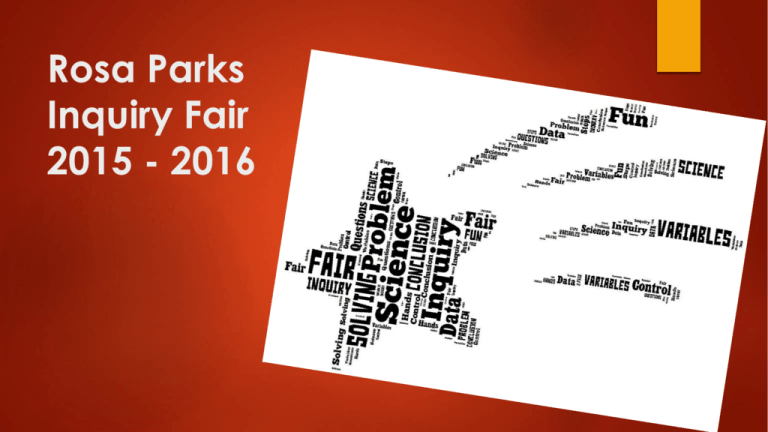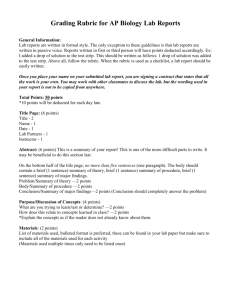Inquiry Fair Presentation - Rosa Parks Elementary School
advertisement

Rosa Parks Inquiry Fair 2015 - 2016 What is the Inquiry Fair A chance for students in grades K – 5 to complete a voluntary scientific investigation and present what they have found during their investigation. Classroom IB projects are also presented Two types of projects Classroom Inquiry IB Projects Voluntary Science Fair Projects Prince William County Science Fair Fifth grade winners of Rosa Parks Science Fair are eligible for the PWC Science Fair. Students are entered by category Saturday, April 9th (Projects are dropped off the evening before.) Categories Science Fair Projects Students pick a topic and design an experiment that shows cause (independent variable) and effect (dependent variable) (Think experiment not model) Examples of Science Fair Projects How does salt affect the time it takes for water to freeze? Does the amount of sugar affect how long it takes for crystals to form? Which brand of paper towels absorb the best? Does temperature affect how high mentos/soda will spray? Does the size of a ball impact how high it will bounce? What is not an example Model of solar system Volcano exploding Model of the layers of the earth Diagram of a cell Poster showing the parts of an atom What can we not do for an experiment: • skin, blood, tissue, saliva, sweat, or other body fluids • experiments on animals. • hazardous or controlled substances. • open flames • firearms/weapons • bacterial cultures Steps to complete the project 1. Write a proposal for an idea 2. Design the Experiment 3. Finalize the materials and procedures. 4. Run experiment with adult supervision 5. Organize results(graphs, charts) 6. Put presentation board together Step 1 - Proposals Students submit a proposal sheet with their idea. Students can submit more than one if they aren’t sure if. Due 15th by Friday, January Step 2 - Design the experiment Students complete the Design the Experiment Form Due Friday, January 22nd Step 3 – Finalize materials and procedures Step 4 - Run the experiment Students with adult supervision to finalize and collect materials Students with adult supervision run the experiment. Students collect data in an organized way during the experiment Take photos if possible Begin as soon as the Design the experiment is completed. Step 5 - Organize the data Students create a final copy of their data table Students often take data and create a graph Graph making sites: https://nces.ed.gov/nceskids/createagraph/ http://www.chartgo.com/ Step 6 - Prepare the board USE COLOR • BE CREATIVE • CUT CAREFULLY • USE PHOTOGRAPHS YOU TAKE • USE GRAPHS • TYPE WHEN POSSIBLE TO MAKE IT EASY TO READ • COMPLETED BOARD DUE TUESDAY, FEBRUARY 23RD • What needs to be on the board? Title of experiment Question – What the student is trying to answer Hypothesis – If…, then…. Independent Variable -One thing purposefully caused to be different) Dependent Variable- Effect measured in the experiment Constants – factors kept the same to be fair Control group- group that did not get the independent variable Data/Results(tables and graphs) Procedures – Steps used to complete the experiment Conclusion –paragraph explaining results Dates to remember Proposal Forms due Friday, January 15th Designing an Experiment Form due Friday, January 22nd Project Board due Tuesday, February 23rd Judging will be afterschool on February 25th Classroom IB Projects and Individual Science Projects will be on display from 6:30-7:30 p.m. on Thursday, February 25th Fifth grade winners are eligible to go on to the PWCS Science Fair What resources are there: I will be available to any student Tuesdays from 7:45 – 8:30 am. Parents just need to notify me that their child is coming in for help. Internet Support for Science Investigation Ideas Here are a few websites with ideas and support. Some sites are better than others. Some sites have projects like solar system models missed in with scientific investigations. Please review carefully and ask me questions if you are unsure. 1. 2. 3. 4. 5. 6. •7. www.sciencebob.com http://members.ozemail.com.au/~macinnis/scifun/projects.htm http://users.rcn.com/tedrowan/primer.html http://sciencefairproject.virtualave.net/observation.htm http://faculty.washington.edu/chudler/fair.html www.sciencebuddies.org ttp://fair.science-resources.org/questions.htm Graph making sites: •https://nces.ed.gov/nceskids/createagraph/ •http://www.chartgo.com/ Sample Project Materials: String Washers Timer Does the amount of weight affect how many times a pendulum swings? Hypothesis: If there is more weight, then the pendulum will swing more times. Independent Variable : Amount of weight Dependent Variable : Number of times it swings Procedure: 1. 2. 3. Tables: Showing Results of each trial Graphs of Results: Constants: 1. Length of string 2. Height dropped Control: Pendulum with one washer Conclusion: Describe in paragraphs what you did, results, any thing you learned, any questions for future investigations





